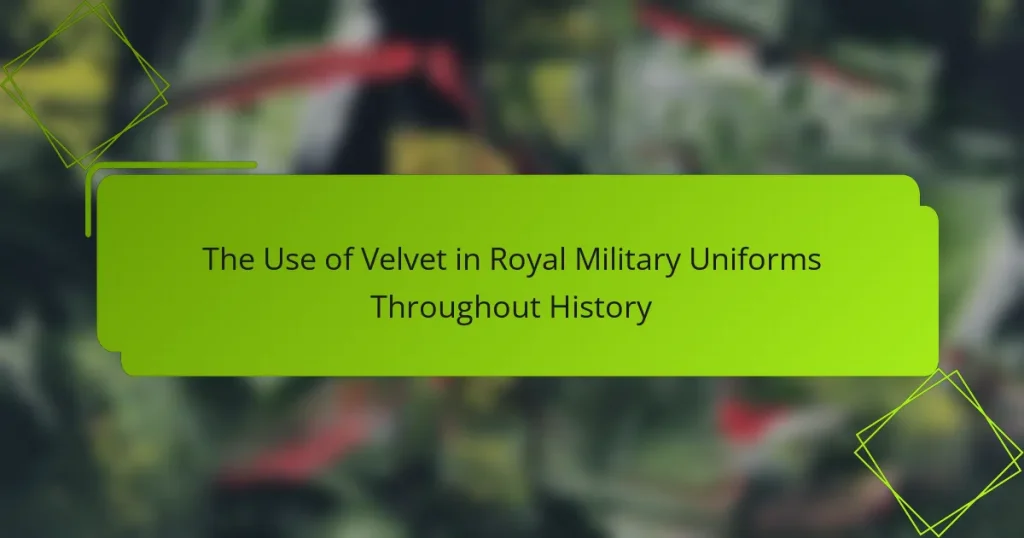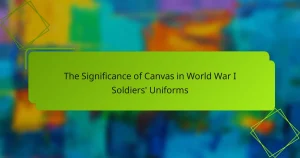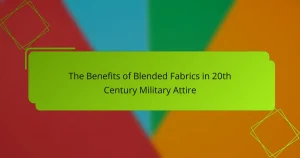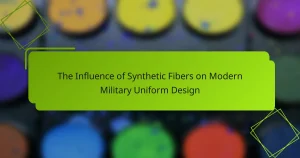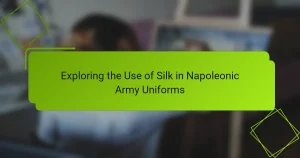The article focuses on the use of velvet in royal military uniforms, highlighting its historical significance and contemporary applications. Velvet is a luxurious fabric historically associated with nobility, authority, and high-ranking officials, often used in ceremonial military attire to signify status and power. The article examines examples from the 17th century to modern-day practices, illustrating how velvet enhances the visual impact of uniforms and serves practical purposes, such as providing warmth. Additionally, it discusses the ongoing influence of historical traditions on the use of velvet in military contexts, reinforcing its role as a symbol of honor and prestige.
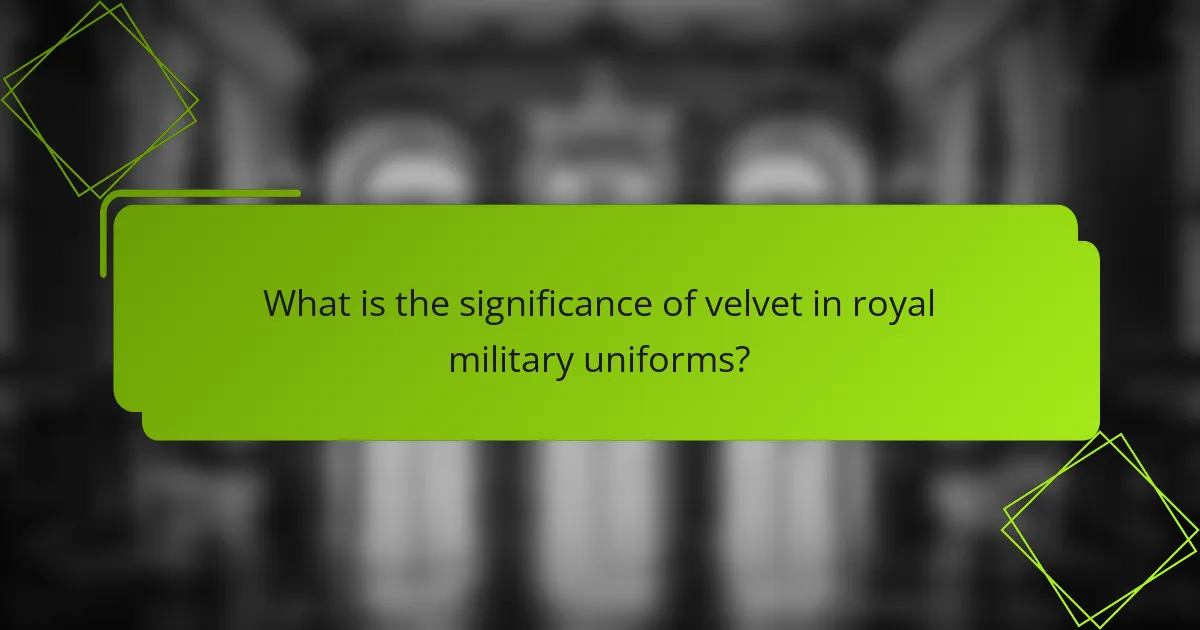
What is the significance of velvet in royal military uniforms?
Velvet in royal military uniforms signifies luxury and status. It has been historically associated with nobility and high-ranking officials. The fabric’s rich texture and sheen convey authority and power. Velvet was often used in ceremonial uniforms to distinguish leaders from regular soldiers. The use of velvet also reflects the wealth of the monarchy, as it was an expensive material. Its incorporation into uniforms indicates the importance of the occasion or rank. Additionally, velvet serves a practical purpose by providing warmth and comfort in colder climates. Overall, the significance of velvet in these uniforms combines aesthetic appeal with symbolic meaning.
How has the use of velvet evolved in military fashion?
The use of velvet in military fashion has evolved significantly over time. Initially, velvet was favored for its luxurious appearance and was used in ceremonial uniforms. During the Renaissance, velvet became a symbol of status among military leaders and was often used in elaborate designs.
In the 17th and 18th centuries, velvet continued to be popular for officer uniforms, particularly in European armies. It was commonly used in regimental coats and other formal attire. The fabric’s rich texture added an element of prestige to military dress.
As military fashion progressed into the 19th century, the use of velvet began to decline in favor of more practical materials. However, it remained prevalent in certain ceremonial contexts, such as parades and state occasions. Today, velvet is rarely used in active military uniforms but is still present in ceremonial dress uniforms.
This evolution reflects broader changes in military fashion, shifting from opulence to functionality while still honoring tradition in ceremonial contexts.
What historical events influenced the adoption of velvet in uniforms?
The adoption of velvet in uniforms was influenced by several historical events. The Renaissance, from the 14th to the 17th century, saw a rise in the use of luxurious fabrics among nobility. This era emphasized status and wealth, which led military leaders to adopt velvet for its opulence. The 18th century further popularized velvet in uniforms during the Age of Enlightenment. This period favored elaborate military attire to reflect power and prestige. The Napoleonic Wars in the early 19th century also impacted uniform design. Armies sought to project strength and sophistication, leading to increased use of velvet in ceremonial uniforms. Additionally, the influence of royal courts, particularly in France and Britain, set trends for military fashion. Velvet became associated with elite status, making it a preferred choice for uniforms.
How does velvet symbolize rank and authority in military attire?
Velvet symbolizes rank and authority in military attire primarily through its association with luxury and prestige. Historically, velvet has been used in uniforms to denote higher status among military personnel. The fabric’s rich texture and appearance convey a sense of importance and distinction.
In many cultures, including European armies, velvet was reserved for officers and ceremonial uniforms. This exclusivity reinforced the hierarchy within military ranks. For example, during the 17th and 18th centuries, velvet was commonly used in the uniforms of generals and nobility, marking their elevated positions.
Additionally, the use of velvet in military attire often included embellishments such as gold or silver thread. These decorative elements further highlighted the wearer’s authority and command. The visual impact of velvet, combined with its historical context, solidifies its role as a symbol of rank and authority in military attire.
What are the characteristics of velvet that make it suitable for military uniforms?
Velvet is suitable for military uniforms due to its durability, comfort, and aesthetic appeal. The fabric is known for its soft texture, which enhances comfort for wearers during extended use. Velvet also has a luxurious appearance, making it visually striking and suitable for ceremonial occasions. The dense pile of velvet provides insulation, helping to keep soldiers warm in cooler climates. Additionally, its ability to hold dyes well allows for vibrant colors, which can represent military regiments effectively. Historically, velvet has been used in various military uniforms, signifying rank and prestige. Its strength and resilience make it a practical choice for uniforms that require both functionality and style.
What are the physical properties of velvet that contribute to its use in uniforms?
Velvet possesses several physical properties that make it suitable for use in uniforms. Its soft texture provides comfort against the skin. The fabric has a luxurious appearance, enhancing the visual appeal of uniforms. Velvet is dense, which offers warmth and insulation in cold conditions. It also has a natural sheen, giving uniforms a distinguished look. The fabric’s durability allows it to withstand wear and tear. Additionally, velvet drapes well, allowing for elegant tailoring in uniform designs. Its ability to hold dye results in vibrant colors that maintain their richness over time. These properties collectively contribute to the practicality and aesthetic value of velvet in military uniforms.
How does velvet’s texture and appearance enhance military uniforms?
Velvet’s texture and appearance enhance military uniforms by providing a luxurious, visually striking aesthetic. The soft, rich surface of velvet creates an impression of elegance and authority. This texture also helps to absorb light, reducing glare and enhancing the uniform’s overall appearance in various lighting conditions. Historically, velvet has been associated with nobility and status, making it suitable for military leaders. The fabric’s durability adds to its functional benefits, ensuring that uniforms maintain their appearance over time. Additionally, velvet’s ability to hold vibrant colors contributes to the uniform’s visual impact. The use of velvet in military attire signifies prestige and tradition, reinforcing the identity of the armed forces.
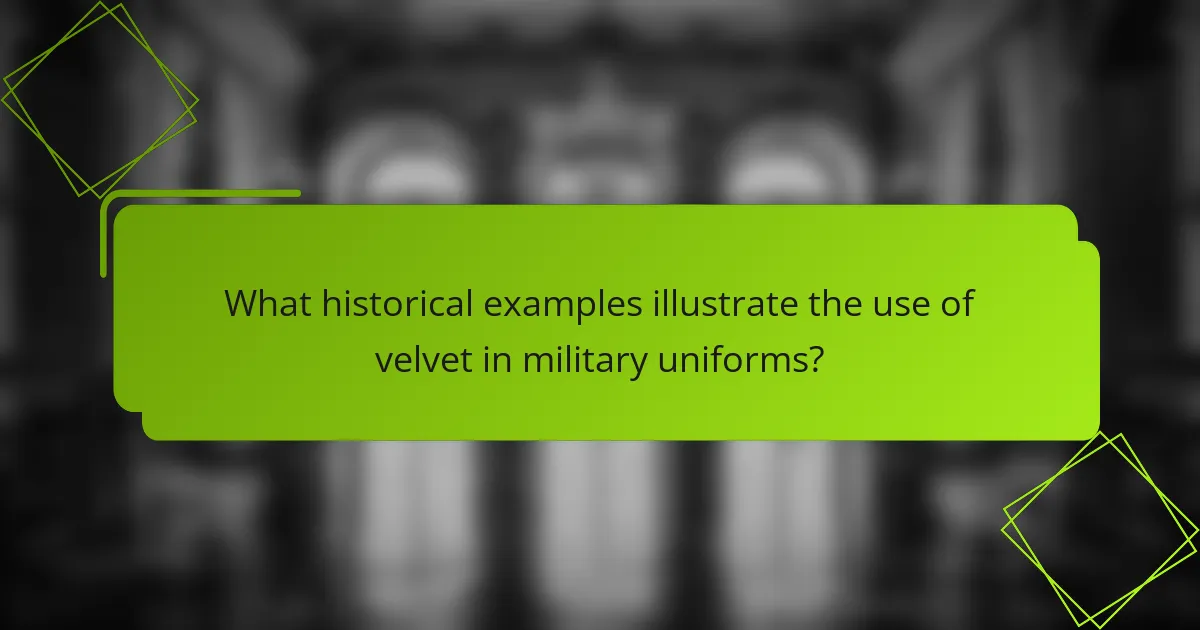
What historical examples illustrate the use of velvet in military uniforms?
Velvet has been used in military uniforms historically, particularly in royal contexts. For example, during the 17th century, velvet was a prominent fabric for the uniforms of European nobility. The British Army’s uniforms in the 18th century featured velvet in ceremonial attire. Additionally, velvet was used in the uniforms of the French Imperial Guard during the Napoleonic Wars. These instances highlight the fabric’s association with prestige and authority in military attire. The rich texture of velvet symbolized power and status in these historical examples.
Which royal armies historically utilized velvet in their uniforms?
Several royal armies historically utilized velvet in their uniforms. The British Army incorporated velvet into uniforms during the 18th century. The French Army also used velvet for ceremonial uniforms, especially in the 17th and 18th centuries. Additionally, the Russian Imperial Army featured velvet in their uniforms, particularly for high-ranking officers. Velvet was favored for its luxurious appearance and texture. These armies employed velvet to signify status and enhance the visual impact of their uniforms during formal occasions.
What specific uniforms featured velvet prominently?
Royal military uniforms, particularly those of the 17th and 18th centuries, prominently featured velvet. The British Army’s ceremonial uniforms often included velvet fabric, especially in the regalia of high-ranking officers. The French Imperial Guard uniforms were also known for their luxurious velvet elements. Additionally, the uniforms of various European royal guards, such as the Swiss Guard, utilized velvet for its aesthetic appeal. Velvet was favored for its rich texture and visual impact in military attire, symbolizing prestige and authority.
How did cultural influences shape the design of these velvet uniforms?
Cultural influences significantly shaped the design of velvet uniforms through symbolism and aesthetics. Velvet, historically associated with nobility, was chosen to convey prestige. In various cultures, colors and patterns in velvet reflected social status and military rank. For example, red velvet was often used in British military uniforms to symbolize courage. Additionally, regional styles influenced cut and embellishments. French designs incorporated intricate embroidery, showcasing artistry. The use of velvet also aligned with the cultural emphasis on opulence in ceremonial attire. Thus, cultural contexts directly impacted the choice of materials, colors, and design elements in velvet uniforms.
What role did velvet play in ceremonial military attire?
Velvet served as a symbol of prestige and luxury in ceremonial military attire. It was often used in the uniforms of high-ranking officers and ceremonial regalia. The fabric’s rich texture and appearance conveyed authority and status. Historically, velvet was associated with nobility and was used in various European armies. Its use indicated the importance of the occasion, such as parades and state events. Velvet also provided a distinctive visual contrast against other fabrics. This made military leaders stand out during ceremonies. The historical significance of velvet in military attire reflects its role in showcasing power and tradition.
How does ceremonial use differ from practical military applications of velvet?
Ceremonial use of velvet emphasizes aesthetics and tradition, while practical military applications focus on functionality and durability. Velvet in ceremonial contexts is often used for uniforms, sashes, and regalia, showcasing rank and heritage. This use enhances visual appeal during parades and formal events. In contrast, practical military applications prioritize materials that withstand wear, weather, and combat conditions. Historical examples include wool or cotton blends used in active duty uniforms. The distinction lies in the purpose; ceremonial velvet signifies prestige, whereas practical applications ensure operational effectiveness.
What occasions typically featured velvet in military dress codes?
Velvet in military dress codes typically featured during ceremonial occasions. These occasions included state functions, parades, and formal receptions. Velvet was often used in uniforms for high-ranking officers. The fabric symbolized prestige and authority. Historical records indicate its use in royal and imperial ceremonies. Velvet was also present in regimental dress for special events. The luxurious nature of velvet enhanced the visual appeal of military attire. This tradition persists in some modern military uniforms today.
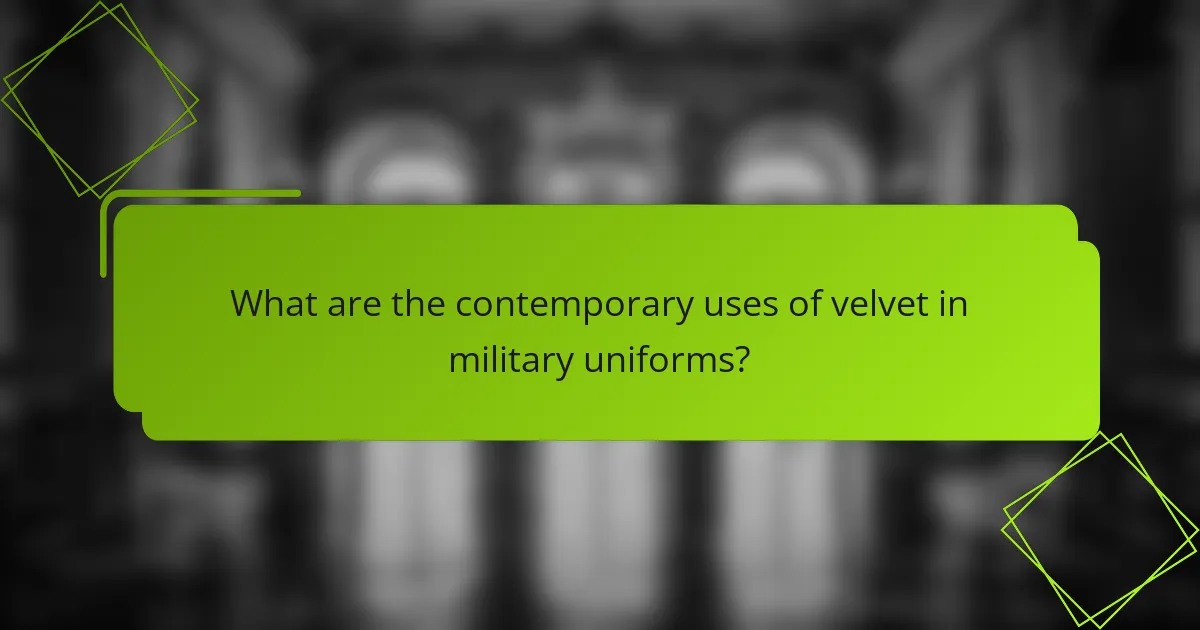
What are the contemporary uses of velvet in military uniforms?
Contemporary uses of velvet in military uniforms include ceremonial attire and specific insignia applications. Velvet is favored for its luxurious appearance and texture. It is commonly used in dress uniforms for formal events. Military bands often utilize velvet in their uniforms to convey prestige. Additionally, velvet may be employed in the production of rank insignia and epaulettes. The fabric’s rich color and sheen enhance visual impact. Historical traditions influence the continued use of velvet in modern military fashion. Velvet remains a symbol of honor and tradition in military contexts.
How is velvet viewed in modern military fashion?
Velvet is viewed as a luxurious and decorative fabric in modern military fashion. It is often used in ceremonial uniforms and high-ranking officer attire. The fabric adds elegance and distinction to military dress. Additionally, velvet symbolizes tradition and heritage in military contexts. This usage reflects historical practices where velvet was favored for its rich texture. Modern military fashion incorporates velvet to maintain a connection with historical uniforms. The incorporation of velvet is generally limited to formal occasions. Overall, velvet’s role emphasizes the blend of tradition and modernity in military aesthetics.
What are the current trends regarding velvet in military uniforms?
Current trends regarding velvet in military uniforms include a resurgence in its use for ceremonial attire. Velvet is being favored for its luxurious appearance and historical significance. Many modern military units are incorporating velvet into uniforms for parades and formal events. This trend emphasizes tradition while adding a contemporary flair. Countries with rich military histories often choose velvet for its symbolic value. For instance, velvet is commonly used in the uniforms of royal guards. The fabric’s texture enhances visual appeal and distinguishes ceremonial uniforms from standard operational gear. Overall, velvet remains a popular choice for ceremonial military attire, reflecting both heritage and prestige.
How do modern materials compare to traditional velvet in military attire?
Modern materials, such as synthetic fibers and advanced textiles, offer superior durability and functionality compared to traditional velvet in military attire. Unlike velvet, which is soft and luxurious but less resilient, modern materials are designed to withstand harsh conditions. They provide better moisture-wicking properties and breathability. Additionally, modern fabrics often include features like stain resistance and lightweight construction. These advancements enhance comfort and mobility for military personnel. Studies have shown that synthetic materials can significantly reduce wear and tear in rugged environments, making them more practical for military use.
What are the practical considerations for using velvet in military uniforms today?
Velvet is not commonly used in modern military uniforms due to several practical considerations. Its durability is lower compared to synthetic fabrics that are designed for harsh conditions. Velvet is also heavier, which can hinder mobility for soldiers in the field. The fabric is less breathable, leading to discomfort in varying climates. Additionally, velvet is more difficult to clean and maintain, which is crucial for military operations. Its cost is higher than alternative materials, making it less feasible for large-scale uniform production. These factors contribute to the limited use of velvet in contemporary military attire.
How do maintenance and durability concerns affect the use of velvet?
Maintenance and durability concerns significantly influence the use of velvet in royal military uniforms. Velvet is a luxurious fabric known for its rich texture and aesthetic appeal. However, it is prone to wear and tear, especially in high-contact areas. This vulnerability necessitates careful handling and regular maintenance to preserve its appearance.
The fabric can be difficult to clean, often requiring specialized care to avoid damage. Consequently, military uniforms made from velvet may need more frequent replacements compared to those made from sturdier materials. Historical records indicate that velvet was often reserved for ceremonial occasions rather than everyday use due to these concerns.
As a result, the practicality of velvet in military attire is often outweighed by its maintenance requirements. This has led to a preference for more durable fabrics in functional military applications. The balance between aesthetics and functionality remains a key consideration in the use of velvet for military uniforms.
What innovations are being made to enhance velvet’s performance in uniforms?
Innovations to enhance velvet’s performance in uniforms include the development of moisture-wicking properties. These improvements allow velvet to better manage sweat and humidity. Additionally, advancements in fabric treatments increase durability and resistance to wear. Enhanced colorfastness is also achieved through modern dyeing techniques. These innovations ensure that velvet maintains its appearance over time. Furthermore, lightweight blends with synthetic fibers improve comfort without sacrificing the luxurious feel of velvet. Research indicates that these advancements lead to improved functionality in military uniforms, supporting both aesthetics and performance.
What tips can help in choosing velvet for military uniforms?
Choose high-quality velvet for military uniforms to ensure durability and appearance. Look for a heavy weight, which provides structure and longevity. Consider the color, as it should align with military standards and regulations. Check for a dense pile to enhance the fabric’s visual richness and resilience. Ensure the velvet is easy to clean and maintain, as uniforms require regular care. Evaluate the fabric’s breathability for comfort in various climates. Verify that the velvet meets any specific military specifications or guidelines. Finally, consider sourcing from reputable suppliers known for military-grade materials.
Which factors should be considered when selecting velvet for uniforms?
When selecting velvet for uniforms, factors include durability, texture, color, and weight. Durability ensures the fabric withstands wear and tear in military settings. Texture affects comfort and appearance, influencing how the uniform looks in formal settings. Color selection should align with military regulations and historical significance. Weight impacts the uniform’s suitability for different climates and activities. Additionally, ease of maintenance is crucial for preserving the uniform’s appearance over time.
How can one ensure quality and authenticity in velvet military attire?
To ensure quality and authenticity in velvet military attire, one should examine the fabric’s composition and craftsmanship. Authentic velvet military attire is typically made from high-quality silk or cotton blends. Inspecting the weave can reveal the fabric’s density and durability. Authentic pieces often feature intricate embroidery and detailed embellishments. These details should match historical designs specific to the military unit represented.
Purchasing from reputable suppliers or established military uniform manufacturers enhances authenticity. Researching the historical context of the attire can provide insights into specific insignia and color patterns used. Collectors should also seek documentation or provenance for vintage pieces to verify their authenticity.
Quality can be further assessed by checking for consistent stitching and finishing techniques. Authentic military attire often follows strict regulations regarding cut and fit, reflecting the era’s standards. Engaging with experts or historians can provide additional validation of the attire’s authenticity.
The main entity of the article is velvet, specifically its use in royal military uniforms throughout history. The article examines the significance of velvet as a symbol of luxury and status in military attire, detailing its historical evolution from ceremonial use to its contemporary applications. It discusses the characteristics of velvet that make it suitable for uniforms, the cultural influences on its design, and the practical considerations regarding maintenance and durability. Additionally, it highlights specific historical examples and the royal armies that utilized velvet, along with current trends in military fashion that continue to honor this traditional fabric.
